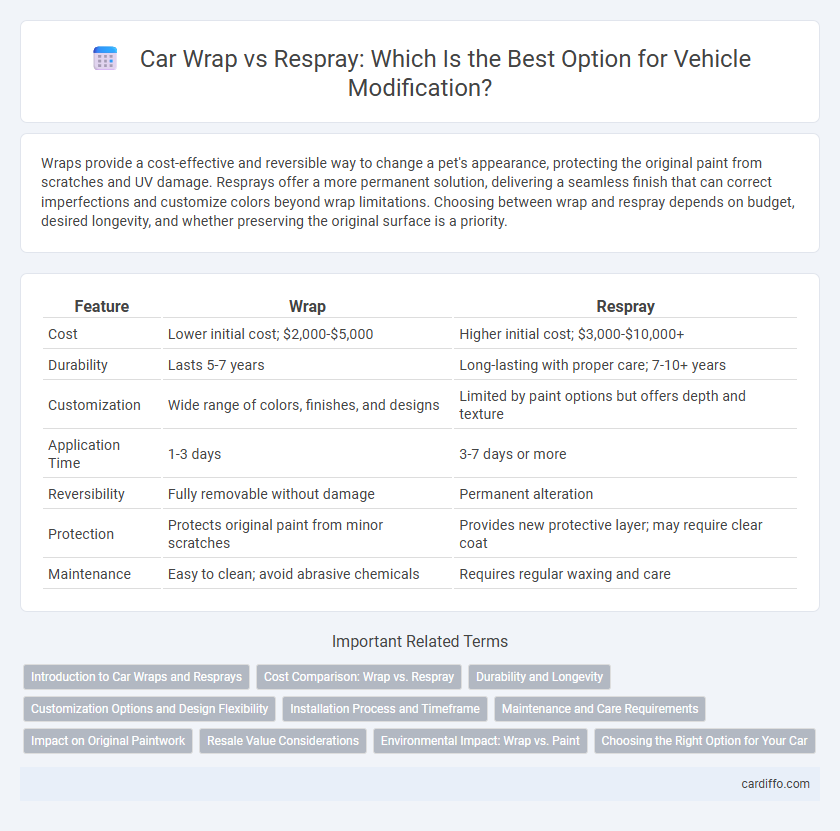Wraps provide a cost-effective and reversible way to change a pet's appearance, protecting the original paint from scratches and UV damage. Resprays offer a more permanent solution, delivering a seamless finish that can correct imperfections and customize colors beyond wrap limitations. Choosing between wrap and respray depends on budget, desired longevity, and whether preserving the original surface is a priority.
Table of Comparison
| Feature | Wrap | Respray |
|---|---|---|
| Cost | Lower initial cost; $2,000-$5,000 | Higher initial cost; $3,000-$10,000+ |
| Durability | Lasts 5-7 years | Long-lasting with proper care; 7-10+ years |
| Customization | Wide range of colors, finishes, and designs | Limited by paint options but offers depth and texture |
| Application Time | 1-3 days | 3-7 days or more |
| Reversibility | Fully removable without damage | Permanent alteration |
| Protection | Protects original paint from minor scratches | Provides new protective layer; may require clear coat |
| Maintenance | Easy to clean; avoid abrasive chemicals | Requires regular waxing and care |
Introduction to Car Wraps and Resprays
Car wraps involve applying large vinyl sheets directly to the vehicle's surface, offering a reversible and customizable option for changing a car's appearance without affecting the original paint. Resprays, in contrast, require repainting the vehicle with new layers of paint, providing a permanent color change but often at a higher cost and longer downtime. Both methods serve as popular vehicle modification techniques, with wraps favored for versatility and protection, while resprays deliver durable, factory-like finishes.
Cost Comparison: Wrap vs. Respray
Vehicle wraps typically cost between $2,000 and $5,000, offering a lower upfront investment compared to resprays that average $3,500 to $8,000 depending on paint quality and labor. Wraps provide temporary protection and can be removed or updated more easily, whereas resprays deliver a longer-lasting finish but involve higher material and labor costs. Considering budget and durability needs, wraps are often more cost-effective for short-term customization, while resprays suit long-term vehicle refinishing.
Durability and Longevity
Vehicle wraps offer superior durability by using high-quality vinyl designed to withstand UV rays, weather, and minor abrasions, maintaining appearance for up to 7 years with proper care. Resprays, though providing a uniform finish, are more prone to chipping, fading, and require regular maintenance to preserve longevity, typically lasting 3 to 5 years before noticeable deterioration. Choosing wraps enhances long-term protection and color retention, making them a cost-effective solution compared to frequent respray jobs.
Customization Options and Design Flexibility
Vehicle wrap offers extensive customization options with a wide variety of colors, finishes, and graphic designs that can be easily applied and changed, providing unparalleled design flexibility. Respray customization is more limited by paint color availability and requires more time and cost to alter the design once completed. Wraps enable precise patterns, textures, and full-vehicle coverage without permanent commitment, enhancing personalization possibilities.
Installation Process and Timeframe
Vehicle wrap installation typically takes between 2 to 5 days, involving surface cleaning, precise vinyl application, and finishing touches to ensure durability and appearance. Respray requires a longer timeframe of 1 to 2 weeks due to thorough sanding, masking, multiple paint coats, and curing processes. Wraps offer a quicker, less invasive option, while resprays demand more extensive preparation and drying time for a permanent finish.
Maintenance and Care Requirements
Vehicle wraps require regular cleaning with mild soap and water to maintain appearance and prevent dirt buildup, avoiding abrasive materials that can damage the vinyl. Resprayed paint demands periodic waxing and polishing to protect the clear coat and preserve gloss, as well as prompt attention to chips and scratches to prevent rust. Both options benefit from storage in shaded or covered areas to minimize UV damage and prolong surface longevity.
Impact on Original Paintwork
Vehicle wraps provide a protective layer over the original paintwork, preserving it from UV damage, minor scratches, and chips, which helps maintain the car's resale value. Resprays involve applying new paint directly onto the surface, which requires sanding and potential chemical treatments that can compromise the original paintwork's integrity. While wraps are reversible and non-invasive, resprays permanently alter the vehicle's exterior, often resulting in a loss of the factory finish and potential depreciation.
Resale Value Considerations
Respraying a vehicle often preserves its original paint quality, which can enhance resale value by maintaining factory finishes that buyers favor. In contrast, wraps might show wear or peeling over time, potentially lowering appeal and resale price if not well maintained. Choosing respray aligns with long-term investment goals, ensuring a smoother, more durable finish that retains market desirability.
Environmental Impact: Wrap vs. Paint
Vehicle wraps generate less hazardous waste compared to traditional respraying, as vinyl materials can often be removed and recycled, whereas paint involves toxic chemicals and solvents that pollute air and water. Wrapping reduces VOC emissions significantly, contributing to improved air quality, while respraying releases volatile organic compounds during application and drying. The eco-friendly nature of wraps aligns with sustainable automotive practices, minimizing environmental harm throughout the vehicle modification process.
Choosing the Right Option for Your Car
Choosing between a car wrap and a respray depends on factors like budget, durability, and desired finish. Car wraps offer a cost-effective, reversible option with a wide variety of colors and designs, ideal for temporary changes or advertising. Resprays provide a long-lasting, factory-quality finish that is more permanent and suitable for restoring or increasing vehicle value.
wrap vs respray Infographic

 cardiffo.com
cardiffo.com